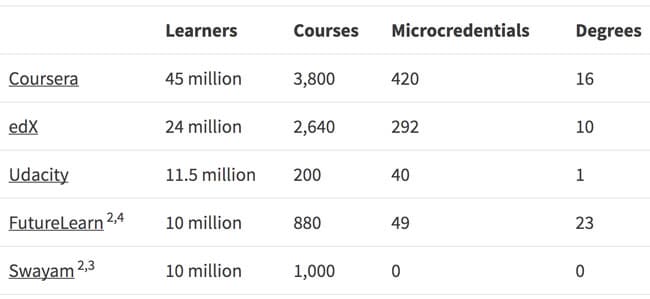Slower growth in new MOOC degrees but online learning is alive and well
Last year, Class Central observed a rush among universities and four of the main MOOC (Massive Open Online Courses) providers – Coursera, edX, FutureLearn, and Udacity – to release new online degrees. The provision of degrees marked an evolution in the MOOC space because (a) they require more time and money from learners than other types of MOOC courses, and (b) they offer learners the chance of receiving a degree from a top university via online study.
But the momentum towards offering new degrees now appears to be slowing among MOOC providers according to Class Central’s latest market analysis.
The background on online degrees
Degrees are in most cases thought to offer more compelling proof of expertise than micro-credentials. Sean Gallagher writes in his book The Future of University Credentials that “they represent a greater level of commitment, depth, achievement and perseverance” and “an achievement that is distinct from simply mastering the knowledge and skills in a particular programme.”
For universities, the option of offering MOOC degrees also allowed them to broaden their programmes and revenue models. “Exclusivity is not the brand differentiator that it used to be,” Michael Feldstein, publisher of the e-Literate blog and a consultant who helps universities choose partners with whom to launch their programmes (known as OPMs or Online Programme Managers) told The Atlantic. “The top-tier schools don’t need to be exclusive anymore to maintain their reputation.”
So far experts agree that there is wide variability in how well universities and their chosen OPM and MOOC providers are delivering their degrees.
Feldstein adds, “Whether you’re reaching students in the other parts of the globe or reaching non-traditional students in the United States, universities are not wired to do that yet. They’ve never had to ... Chances are pretty good that they are not doing it the best way possible yet. They’re just experimenting.”
Slower degree growth
In 2018 Coursera, edX, FutureLearn, and Udacity released 29 new degrees among them. In 2019, there were only 11 new degrees from these providers. This is still growth, but obviously at a more modest pace.
Meanwhile, the number of “traditional” MOOC courses leading to micro-credentials, badges, certificates is increasing at a faster rate. Mr Gallagher writes in Harvard Business Review that “by leveraging algorithms and operating at truly disruptive price points, these programmes are less expensive for colleges to operate and market, and less expensive for the student.”
In other words, universities appear to find it more affordable and effective to expand their micro-programmes than their degree offerings. The marketing investment associated with reaching prospects for online graduate degrees, for example, is extremely high, especially regarding the fees paid to OPMs. An analysis by Eduventures Research, a division of ACT/NRCCUA, found that OPMs “take anywhere between 30% and 80% of the revenue the online degree programmes bring into the schools.”
Degrees aside, millions more new users for MOOCs
The number of new MOOC users is increasing at various rates across the four platforms. Coursera – which reached a valuation of over USD$1B in 2019 – moved from 37 million to 45 million in 2019. EdX moved from 18 million to 24 million; Udacity went from 10 million to 11.5 million; and UK-based Future-learn added more than a million users for a 2019 total of 10 million.

Class Central counted 14 million users on China’s XuetangX at the end of 2018. Class Central offers no 2019 figures for the platform but XuetangX says that it now has 24 million.
Overall Class Central estimates that there were 110 million people in the world enrolled in MOOCs in 2019, based on the MOOC platforms whose data was available to them.
SWAYAM hopes to revolutionise Indian higher education
Outside of Western-based MOOCs and XuetangX, there are millions of learners on India-based SWAYAM (10 million). SWAYAM, which offers all of its courses for free to extend access to higher education in India – is also integrated into India’s traditional higher education system. Public higher education institutions may offer students the opportunity to complete up to 20% of their degrees online on SWAYAM. It’s a fascinating model:
“Twice a year, institutions pick SWAYAM courses they’ll grant credit for in the upcoming term. Note that they may pick courses offered by other institutions, allowing them to tap into the strengths of schools nationwide to build richer curricula. For instance, they may leverage SWAYAM to offer high-demand courses for which they lack qualified instructors on campus.
Students may then register for relevant, credit-eligible online courses and, upon completion, have them count toward their degree. Courses typically involve watching lectures, submitting assignments, and sitting an exam in one of the 1,000 exam centres established across India.”
Growth slowing but numbers still massive
The number of new users on MOOC platforms may not be growing as quickly as in past years, but the user base remains staggering. As Ray Schroeder notes in Inside Higher Ed:
“The MOOC did not die. Rather, it grew up into a mature, fully functional degree platform that is serving millions of learners globally on a daily basis. At-scale learning is too large to ignore. It is changing the learning environment worldwide. In less than a decade, this phenomenon has moved from the fringes of education to the fastest-growing format for certificates and degrees.”
Despite grumblings about low completion rates attached to many MOOCs, a 2015 study, “Who’s Benefiting from MOOCs, and Why” published in Harvard Business Review found that “of the respondents who had completed individual MOOCs, 72% reported career benefits and 61% reported educational benefits.”
For additional background, please see:
















